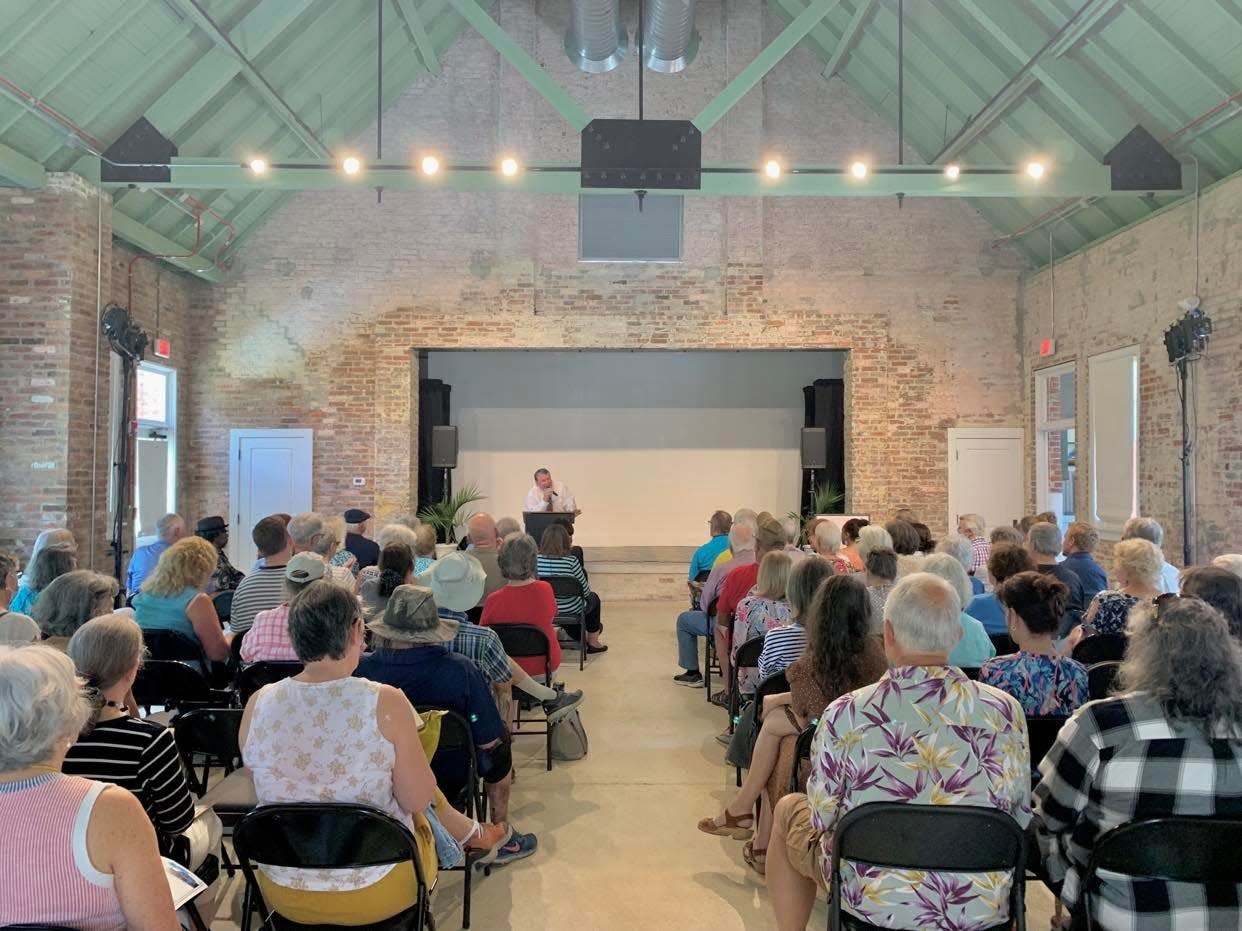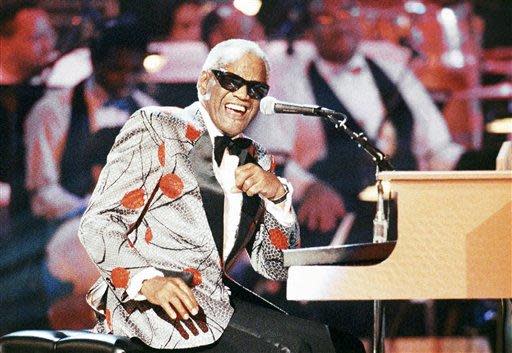Famous authors, artists and musicians created their work in St. Augustine

- Oops!Something went wrong.Please try again later.
- Oops!Something went wrong.Please try again later.
Historian David Nolan spoke to an audience of nearly 100 people on May 5 in the historic St. Augustine Water Works building, recently renovated by the city and leased a few months ago by the St. Johns Cultural Council.
Nolan’s “Cultural Lights of St. Augustine,” a lecture in partnership with the Friends of the Main Library and the cultural council, highlighted famous authors, artists and musicians who have lived or visited St. Augustine over the years — and have left their mark in the cultural landscape of the nation’s oldest city.
He recalled having attended other cultural events in the Water Works building when it served as a space for the St. Augustine Garden Club, such as a Tom Paxston concert in the 1960s. The singer-songwriter had well-known songs such as “The Last Thing on My Mind,” “Bottle of Wine,” “Whose Garden was This,” and “Ramblin' Boy.”
Local history: St. Augustine's most noteworthy historic homes bring city's past to life
Where History Lives: Fun facts about St. Augustine you may not already know
Historic places: Travel back in time with a spin down St. Augustine's Old Brick Road
“I always think of him when I pass by this way along San Marco Avenue,” Nolan said.
Nolan also spoke on the same stage 30 years ago for a garden club event, celebrating the 200th anniversary of William Bartram’s “Travels,” published in 1779, which highlights his travels in the American South, including St. Augustine and St. Johns County, and his encounters with Native Americans between 1773 and 1777. The sites he visited here are part of the Bartram Trail, with historical markers in those areas, along with schools, parks and neighborhoods named after William Bartram.
Nolan said that author Marjorie Kinnan Rawlings was an admirer of Bartram. Rawlings moved to the St. Augustine area when she purchased a house in Crescent Beach that was originally built in the 1930s.
“But not only did Marjorie live there, she bought it with money made from ‘The Yearling,’ which was the No. 1 best-selling novel of 1938, and the No. 6 best-selling novel of 1939, and which won her the Pulitzer Prize for fiction,” Nolan said.
“She was living over in Cross Creek, which is in the proverbial ‘middle of nowhere’ and when she got a little money, she did the first thing that Floridians do, she bought herself a beach house. It was a simple cottage at Crescent Beach.”
Rawlings had previously rented the cottage and wrote one of her favorite stories there, “The Pelican’s Shadow,” which was published on Jan. 6, 1940, in The New Yorker.
“She was visited there by a kind of who’s who of international literature … Robert Frost, Ernest Hemingway, Zora Neale Hurston, Dylan Thomas.”
A friendship blooms
Author Hurston was born in Alabama but grew up in Eatonville, Florida. She visited and lived in St. Augustine several times during the 1920s through the 1940s. She portrayed racial struggles in the early-1900s American South. The most popular of her four novels is “Their Eyes Were Watching God,” published in 1937.
Her autobiography, “Dust Tracks on a Road,” was completed just before the attack on Pearl Harbor and revised in St. Augustine. The book won the 1942 Anisfield-Wolf Book Award, sponsored by Saturday Review magazine, for its contribution to race relations. It was typed by the wife of a local dentist in St. Augustine.
“Zora had many skills, but typing wasn’t necessarily one of them,” Nolan explained. “So, one day at a sporting event at Florida Memorial (a St. Augustine college where she taught briefly), she leaned over to a man next to her and said she was looking for someone who could type. That man was Dr. Rudolph Gordan, a local Black dentist, and he told her that his wife could type.”
So Rosie Gordon Mills, who lived to about 100 years old, was visited by many authors over the years, who wanted to talk to her about Hurston. More than 30 books have been written about her since her death in 1960.
Nolan talked of Hurston’s well-known friendship with Rawlings, which was documented in a play called “A Tea With Marjorie Kinnan Rawlings and Zora Neale Hurston,” written by Florida A&M English professor and playwright Barbara Speisman in 1986.
Nolan told the story of Rawlings inviting Hurston to tea at the Warden Castle (now Ripley’s Believe it or Not! Museum), which was owned by Norton Baskin, who became Rawlings' husband in 1941.
“Norton had been running a hotel in Ocala, and Rawlings became an investor of Castle Warden,” Nolan said. “They opened it up and got married in St. Augustine at the old St. Johns County Courthouse, which is now a parking lot at the corner of Charlotte and Treasury streets.”
Hurston had invited Rawlings to speak to her class during summer school at Florida Memorial. As a thank you, Rawlings invited Hurston to tea.
“And then Marjorie went back and said ‘Whoops,’ because the Castle Warden was a segregated hotel and one of the regulars at happy hour was the daughter of Gen. Edmund Kirby Smith,” Nolan explained.
“So she went to her husband and said, ‘I may have created a little problem,’ but Norton said he would have someone whisk Hurston to the elevator and away before the Confederate General’s daughter comes in …”
That plan was changed when Hurston went around to the kitchen of the hotel, and was taken up to Rawlings’ apartment, where they chatted and became fast friends.
St. Augustine notables
Nolan’s lecture also included insight and history about artist Martin Johnson Heade, who lived in St. Augustine before Henry Flagler arrived, and continued in Flagler’s artist colony. His paintings now sell for more than $1 million at auctions.
He spoke about illustrator Randolph Caldecott, who is buried in St. Augustine’s Evergreen Cemetery. The British author and illustrator came to Florida because of his poor health and died at age 40. The Caldecott Medal was created in 1937 by the American Library Association and honors children’s book illustrators each year.
Nolan also talked about black artist Jacob Lawrence, who was in St. Augustine at the World War II Training Center at Flagler College, and became famous for his War Series artwork.
St. Augustine musical figures included composer Frederick Delius, who came to St. Augustine in 1884 to run an orange grove and was influenced by the African American music of the farm workers, then became a famous composer in Paris.
Performer Ray Charles was a student at Florida School for the Deaf and the Blind from 1937 to 1946, often in trouble for leaving campus and playing in bars in the Lincolnville area of downtown St. Augustine. A piano he played during that time is on view at the Lincolnville Cultural Center and Museum.

Nolan lectures on historic, architectural, and literary subjects. He received the annual author’s award from the Council of Florida Libraries for his first book, “Fifty Feet in Paradise.” In 1995 he collaborated with artist Jean Ellen Fitzpatrick and photographer Ken Barrett to produce “The Houses of St. Augustine,” a bestselling book about the Ancient City and its historic buildings.
He was a founder of ACCORD, a group designed to honor the participants in St. Augustine during the civil rights movement, and in 2009 he was awarded both the Governor’s Points of Light Award for outstanding community service and the President’s Volunteer Service Award, awarded by then-President Barack Obama on the 45th anniversary of the passage of the Civil Rights Act.
The Water Works building was originally built in 1898 as a pumping station and used until 1926 for that purpose. After that, it was converted to a community center, which housed the Little Theatre of St. Augustine, the St. Augustine Art Association, the St. Augustine Garden Club and the Fire Camp Girls over the years.
Community and arts events will be held in the space, coordinated by the SJCC. Upcoming events include A Classic Theatre’s “The Immigrant, on stage May 6-8 and May 13-15. Learn more at aclassictheatre.org.
This article originally appeared on St. Augustine Record: St. Augustine historian gives lecture in renovated Water Works Building

